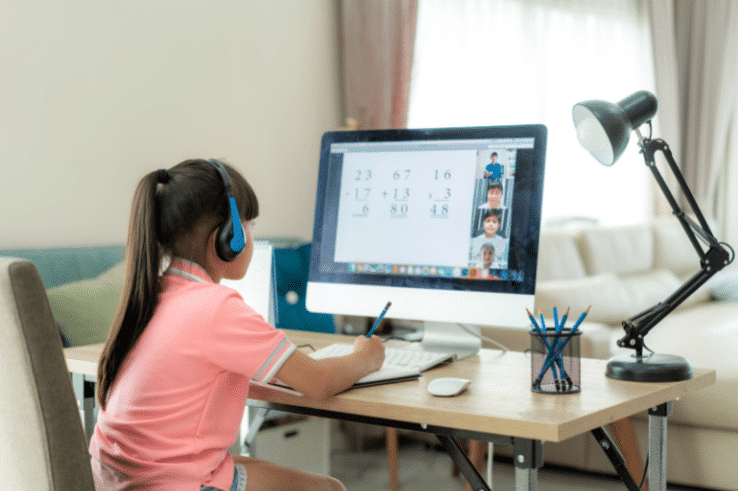
Class is the next generation virtual classroom for K-12, higher education, government agencies, and the workplace. Contact us today to schedule your live demo and see Class in action.

Class is the next generation virtual classroom for K-12, higher education, government agencies, and the workplace. Contact us today to schedule your live demo and see Class in action.

It’s become an all-too-common experience these days: sitting at a desk (or kitchen table) staring at a screen that is populated with box after box of faces of people also sitting at a desk (or kitchen table…).
It’s the Zoom experience and, as Robert O’Toole a senior academic technologist and philosophy graduate at the University of Warwick, points out in a recent essay, for many the experience has become “Zoom and gloom.” It is, he says, “a uniformly crap experience.”
It doesn’t have to be, of course. In fact, doing what O’Toole suggests—designing tools to enhance the Zoom experience—is exactly what Class has done.
The opportunity, says O’Toole, is to humanize the technology experience, or videoconferencing in particular. He exhorts his readers to follow the advice of designer Jon Kolko to “seek to explore the situation space, to see multiple potentials for improvement and to always consider what might be.” While he laments that technology has yet to achieve its promise, its impact could be revolutionary.
Where this could be best achieved, O’Toole writes, is through philosopher Martha Nussbaum’s “fifth capability,” the expression and development of emotions.
O’Toole considers the massive impact that has been leveled on teachers during the pandemic. It’s an impact that has stripped away something most of them (and most of us) held dear—order and predictability in our day-to-day experiences. Loss of regularity, structure, and ritual has led to what he believes is a troubling imbalance between order and chaos. Where, as anthropologists, Tony Becher and Pau Trowler noted back in 2001, instructors were “in correspondence” with others throughout their days, the virtual world doesn’t lend itself—at least not yet—to such correspondence. At least not in ways we find comfortable and comforting. Yet.
And yet this is the world that Class Technologies envisioned when developing Class. Built on Zoom, Class was developed by academic and academic technology experts to feel like a real classroom—to help instructors be “in correspondence” with students and others throughout the day. To reach a state of calm which is something rare in today’s disruptive and fragmented environment.
Empathy and creativity can re-humanize videoconferencing and improve virtual learning.

Calm technology, “the extent to which a technology works so well, fits so perfectly with human needs and habits, that it disappears from view,” is a design goal concept that researchers Mark Weiser and John Seely Brown at Xerox PARC invented and that O’Toole points to as a worthy goal for any tech application. It’s the kind of seamless experience that ultimately leads users to forget they’re even using technology at all.
Class goes beyond “videoconferencing,” which O’Toole says still evokes in him “an odd emotional pain.” We’re certainly glad that videoconferencing and tools like Zoom were available to educators when classes first moved to a remote learning environment in March. Zoom quickly became a popular tool not only for educators but for professionals in businesses of all kinds.
Class removes some of the friction and unnaturalness of typical videoconferencing technology that O’Toole refers to:
Class turns the typical videoconferencing or virtual learning experience on its head to allow educators to create a virtual classroom that meets their unique needs and the needs of their students. The features and functionality that Class offers were designed through understanding how teachers and students interact in ideal learning environments. Then these real-world experiences were reimagined for a digital learning environment. Not in an effort to allow people to “meet,” but in an effort to allow teachers to teach and students to learn—through empathy and creativity.
Can the experience become even better? We think so.

Class is poised to provide educators with the tools they need to build a virtual classroom experience that feels real. Whether at the K-12 or higher-ed level, instructors can do everything they can do in the classroom online—give a lecture, show a video, take attendance, hand out assignments, give a quiz, grade work, talk one-on-one with a student, break students out into small teams for in-class discussion and then reconvene as a group. It’s “calm design” in action. But it’s only the beginning.
As O’Toole points out, designing works through “incremental improvements based on insights drawn from experience.” Experience—ours and yours—will continue to position Class as the go-to solution for creating real-world classroom communities and experiences in a remote environment.

Class is the next generation virtual classroom for K-12, higher education, government agencies, and the workplace. Contact us today to schedule your live demo and see Class in action.

Class is the next generation virtual classroom for K-12, higher education, government agencies, and the workplace. Contact us today to schedule your live demo and see Class in action.
Get our insights, tips, and best practices delivered to your inbox

Sign up for a product demo today to learn how Class’s virtual classroom powers digital transformation at your organization.

Features
Products
Integrations